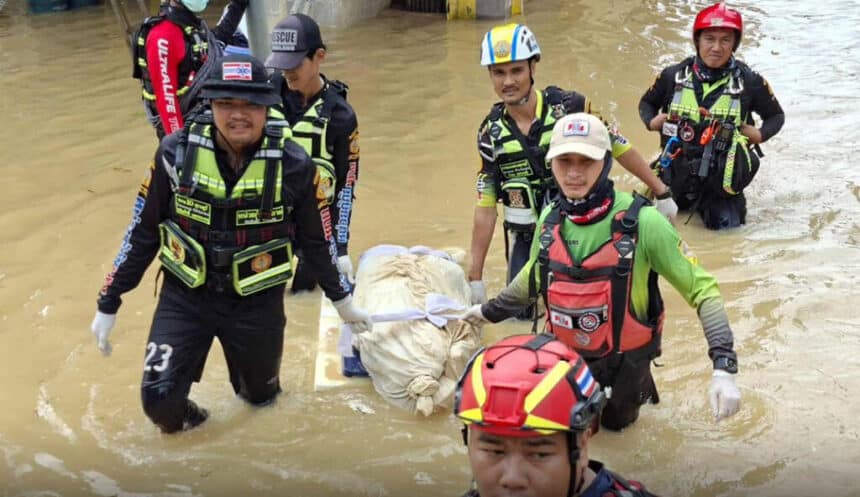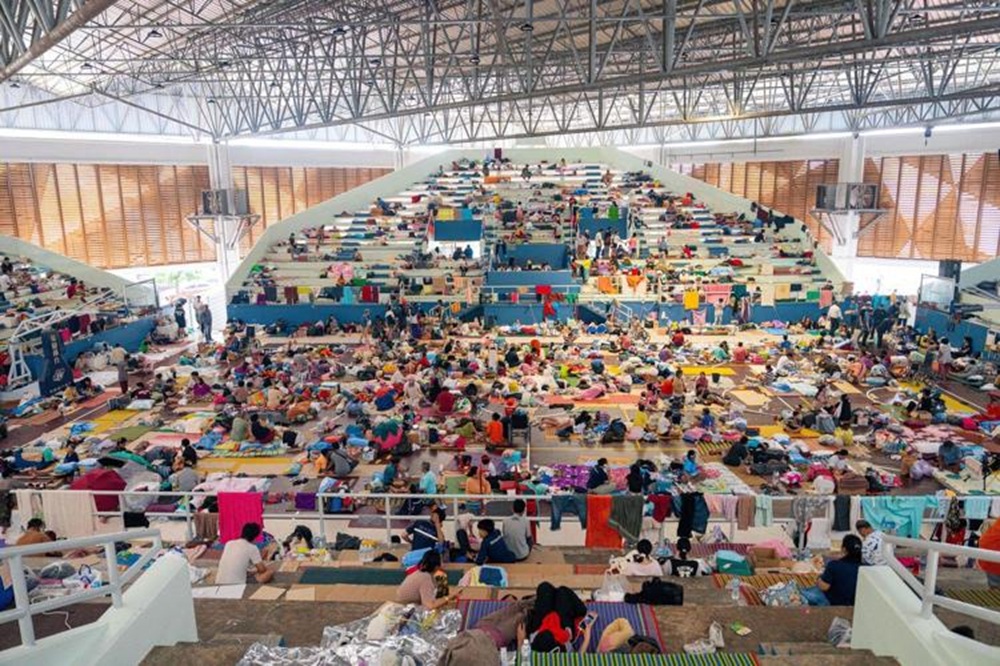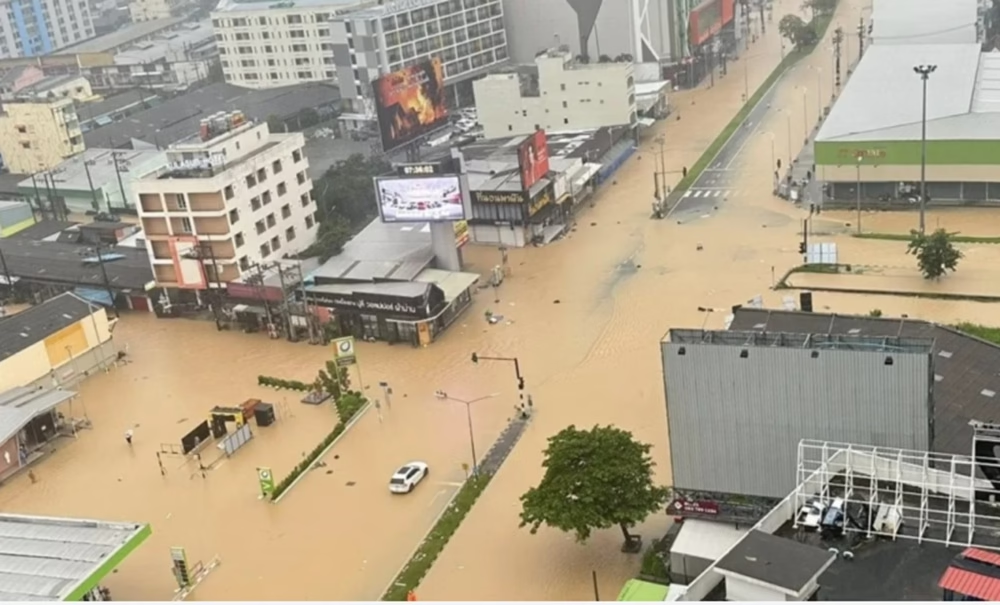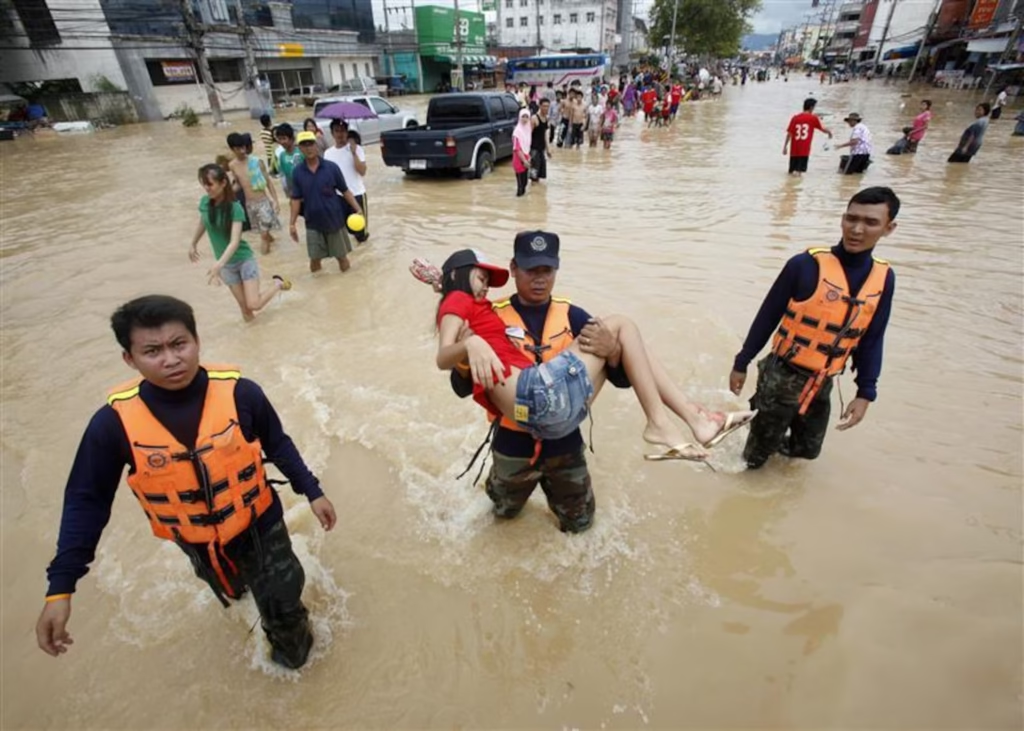HAT YAI – As days of unbroken monsoon rain finally begin to ease over southern Thailand, the scale of the disaster is becoming brutally clear. Authorities now fear that fatalities could exceed 100, with confirmed deaths already passing 80 across seven of the hardest-hit provinces.
The floods, which began on 22 November, have swallowed more than 640,000 households, affecting close to 2 million people. Families are facing destroyed homes, lost income, and mass displacement.
For a country still patching up the economic wounds left by COVID-19, this latest blow is set to cause damage worth billions of baht, stretching community strength and testing how quickly the government can respond.
Meteorologists have described the rainfall as a “once-in-300-years” event. The deluge has flooded 10 provinces: Surat Thani, Krabi, Nakhon Si Thammarat, Trang, Phatthalung, Satun, Songkhla, Pattani, Yala, and Narathiwat. Across 92 districts and more than 4,000 villages, the water has torn through areas that power Thailand’s rubber and palm oil sectors, along with major tourist routes.
What started as localised flash floods has turned into a major humanitarian crisis. Rivers have burst their banks, and major towns like Hat Yai in Songkhla province now resemble vast inland lakes, with roads and neighbourhoods sitting under murky brown water.
Rising Death Toll From Floods
The human tragedy continues to grow. By Thursday evening, the Department of Disaster Prevention and Mitigation (DDPM) reported at least 82 deaths. Most victims died from drowning, electric shocks, or landslides after hillsides gave way in waterlogged areas.
Songkhla province has suffered the most, with 55 deaths recorded there alone, a sharp jump from only six deaths reported the previous day. Many fatalities occurred in low-lying communities around the Songkhla Lake basin, where high tides pushed flood levels even higher and trapped families in their homes through the night.
Accounts from residents are heartbreaking. In Na Thawi district, one of the worst-hit areas in Songkhla, 92 villages and more than 15,000 households remain partially underwater, affecting around 50,000 people.
“The water came so quickly, like a wall rushing down from the hills,” said 62-year-old fisherman Somchai Boonmee. His simple stilt house in Ban Pak Phol collapsed under the force of the water, killing his elderly neighbour. “We shouted for help but the current was too strong. By morning, the village was quiet except for the crying.”
Children and older people have been at particular risk. In Hat Yai, Thailand’s fifth-largest city and a key trading hub, rescue teams have winched vulnerable patients from rooftops, including newborn babies trapped at Hat Yai Hospital when the maternity ward flooded.
Military helicopters, reassigned for emergency use, have shuttled oxygen tanks and medical supplies in and out of the city, where chest-high floodwaters have cut off streets and blocked ambulances.
“We have lost count of how many close calls there have been,” said Lieutenant Colonel Arnon Srisuk of the 4th Army Region. “Jet skis and boats are the only reliable way in and out now.”
Officials expect the death toll to rise as water levels fall and more damaged areas become reachable. Bodies still missing in remote tambons, along with searches in collapsed homes and shops, may push fatalities beyond 100. If that happens, this disaster will surpass the deadly southern floods of 2017, which killed 90 people and forced hundreds of thousands from their homes.
Life in Shelters: Crowded Rooms and Quiet Strength
The floods have upended daily life on a huge scale. Around 13,000 people, many of them whole families who waded out of waist-deep water, are now staying in about 200 emergency shelters in schools, temples, and community halls.
In provinces like Pattani and Nakhon Si Thammarat, where river levels remain dangerously high, many more residents are still stranded. Isolated communities are depending on air drops from the Royal Thai Air Force for bottled water, dried food, and basic supplies.
Inside the shelters, conditions are crowded but calm. At Wat Prachak Silp in Phatthalung, volunteer coordinator Naree Laowattana described a difficult situation held together by shared effort.
“We have about 500 people here now, lying on mats with only the clothes they managed to carry,” she said. “We cook rice porridge twice a day using donations from nearby villages. The children are frightened but they keep drawing pictures of sunny skies and dry land. It helps them cope.”
Power cuts and polluted water sources have made life even tougher. Many wells are now contaminated, and medical teams are working to contain waterborne diseases that spread quickly in packed shelters. Local health staff, already stretched thin, are now dealing with diarrhoea, skin infections, and fevers among evacuees.
The DDPM estimates that almost 3 million people across nine key provinces have felt some impact from the floods. Wider counts suggest more than 1 million households have been affected in total.
However, the focus on 640,000 households highlights the intense damage in core flood zones. These are areas where small farms and rubber plantations are central to daily life, and where around a third of the region’s 3 million households rely on these industries to survive. Many of those fields now sit under mud and tangled debris.
Economic Shock: Losses Topping 140 Billion Baht
Early figures from the government show a severe financial blow. Officials currently estimate losses at no less than 140 billion baht (around 4.3 billion US dollars), already outstripping the cost of the 2017 southern floods.
This amount includes destroyed roads, rail lines, and bridges, as well as halted trade, damaged housing, and ruined farmland. Hat Yai, the main centre of Thailand’s rubber trade, faces the worst of it. The city alone is believed to have lost around 12 billion baht (about 372 million US dollars). Markets, warehouses, and transport hubs are underwater, and daily business has almost ground to a halt.
Tourism has been hit hard as well. Beautiful coastal provinces like Krabi and Trang, usually full of visitors at this time of year, are reporting a steep drop in hotel stays and bookings. Many Malaysian tourists, who make up the largest share of foreign visitors to the south, have cancelled trips because of road closures and safety concerns.
Phattarachai Thaveewong, director of research at Colliers Thailand, warned of longer-term risks for housing and investment. “Hat Yai has 128 active residential projects worth a total of 41.56 billion baht,” he said. “Widespread flooding shakes confidence. Investors hesitate, and that could slow recovery for many years.”
Authorities estimate that daily losses from blocked trade routes and vanished tourist income may reach up to 1.5 billion baht. Economists are already warning that this could drag down national GDP growth for the final quarter of the year.
Prime Minister Anutin Charnvirakul has declared a state of emergency in Songkhla and ordered large-scale military support for rescue and relief operations. This includes using an aircraft carrier to move supplies to cut-off areas. The Cabinet approved an initial relief plan on 23 November, with a focus on quickly confirming which households are affected so that financial aid reaches them first.
“This is a level of severity that Thailand has not seen in the south before,” the prime minister said in a televised statement. “We will rebuild stronger systems and stronger communities, but that will only work if every Thai stands together.”
Slow Recovery and Small Signs of Hope
As water levels start to fall in some provinces, residents are taking the first uneasy steps towards recovery. In Satun and Trang, where rivers are dropping fastest, volunteer groups and local authorities are handing out around 20,000 food boxes each day from central distribution points. Some residents have begun clearing mud from their homes, although many streets are still too wet or dangerous to enter.
International help has begun to arrive. Malaysia’s defence ministry has offered support, even while facing serious floods in eight of its own states that have displaced nearly 50,000 people. Regional cooperation is expected to grow in the days ahead as damage assessments become more precise.
Specialists in climate and weather patterns warn that the road back will be long. Many link the intense monsoon rains to global warming and argue that Thailand needs sustained investment in flood defences, drainage, and early-warning systems. Stronger dykes, better-planned urban drainage, and clearer evacuation routes are among the measures being discussed.
For now, survival depends on shared effort at the ground level. In crowded shelters and sodden villages across southern Thailand, people are leaning on each other for food, shelter, and emotional support.
As one evacuee in Yala put it, “The rain might stop, but the pain will stay with us for a long time. We either stand up together or we stay down together.”
The Chiang Rai Times will keep following developments, bringing first-hand reports and updates from affected communities. Readers who wish to help can donate to the DDPM’s official relief fund through its recognised channels. In a disaster of this scale, every baht really does help families move one step closer to dry, safe homes again.
















